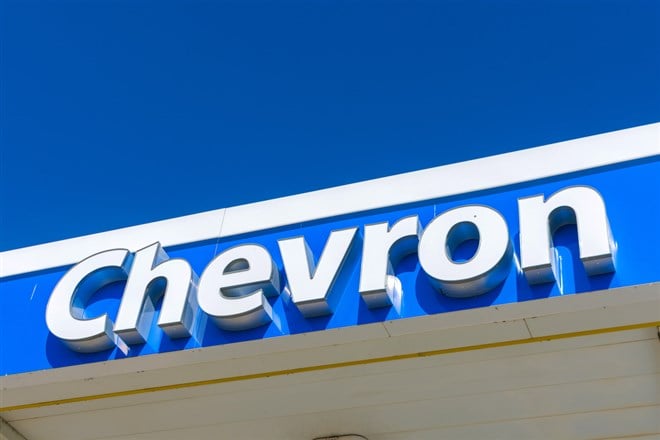
Shares of Chevron Corporation (NYSE: CVX) gapped up 2.10% in heavy volume on February 10, following news that Russia was cutting oil production by 500,000 barrels a day.
With a market capitalization of $332.53 billion, Chevron is the second-largest stock within the S&P energy sector, trailing only Exxon Mobil Corporation (NYSE: XOM). The charts of Chevron and Exxon Mobil reveal that the latter’s price and earnings performances have been stronger in recent months, but is Chevron in a strong position to take sector leadership this year?
Chevron has been forming a flat base with a 12% correction since mid-November, essentially mirroring the consolidation of the wider S&P energy sector, as tracked by the Energy Select Sector SPDR Fund (NYSEARCA: XLF). That could be the setup for a fresh rally.
Wall Street expects Chevron to earn $15.49 per share this year, which would be a 19% year-over-year decrease. Exxon Mobil is seen earning $10.83 a share, a decrease of 23%.
As investors saw throughout 2022, oil-and-gas stocks tended to follow the same upward price and earnings growth trajectories. That was true even for companies such as Halliburton Co. (NYSE: HAL) and Schlumberger Ltd. (NYSE: SLB) which aren’t producers but are in related industries.
Sector Earnings Expected To Fall
Researcher FactSet said it expects the energy sector to report an earnings decline of 12.4% this year, the largest year-over-year decrease among all 11 S&P sectors.
Could geopolitical developments such as Russia’s unilateral decision to slash production change that outlook? Certainly. After all, in January 2022, energy stocks as a whole were languishing in corrections and having a tough time overcoming resistance. You can see that on the chart for the XLE ETF.
As reflected by the ETF’s price action, the entire industry took off when Russia invaded Ukraine in 2022. That was a significant catalyst for a big price move and increased demand in the U.S. as pandemic-era restrictions eased.
Even if sector-wide earnings decline at the projected rate this year, energy companies are still well positioned to generate healthy levels of free cash flow and shareholder dividends.
Chevron’s dividend yield of 3.3% is slightly ahead of Exxon Mobil’s, one characteristic that could make the stock an attractive choice for investors opting for single stocks rather than a basket of energy-related securities.
The company missed earnings views when it reported fourth-quarter results in January, but investors overlooked that news, focusing instead on the company’s $75 billion share buyback program and dividend increase.
Chevron said it would increase its dividend payout to $1.51 from $1.42, with a distribution date of March 10 for shareholders of record as of February 16. That increase will boost the dividend yield to 3.5%, more in line with industry averages.
MarketBeat dividend data for Chevron show a track record of increases going back 37 years.
Buybacks Increasing Total Yield
Including share buybacks over the past 12 months, the total yield to shareholders is 6.70%.
The new buyback program goes into effect on April 1 and has no expiration date as of yet.
Despite forecasts for earnings growth declines, the energy sector is still well-positioned to deliver solid shareholder returns in 2023. Cost inflation for inputs, such as labor, transportation, and materials, is likely to cut into earnings, but the real story is likely to be dividends.
Chevron’s full-year 2022 earnings of $35.5 billion were hefty enough to cover the dividend as well as profit redeployed into growth projects. Analysts believe that looks to be the case in 2023, as well.
Wall Street has a “hold” rating on the stock, according to MarketBeat analyst data, with a price target of $187.10, a potential upside of 9.30%.
Since Chevron reported earnings on January 25, two analysts lowered their price targets but still see the upside. One analyst boosted its price target.
Chevron looks solid right now, as do Exxon Mobile and many other companies in the sector.
However, at this juncture, there’s not much meaningful to be gleaned from comparing chart patterns on the big energy producers, at least in terms of timing a buy. Investors who want to capture the gains from energy in 2023, including dividend yield, may even consider purchasing shares of the XLE or a similar ETF rather than attempting to find a gusher among the vast selection of single stocks.